The first step is to work out what kind of bees you have!
Australia has 1,500 species of native bees.
However, the most common type of bee found in houses is the introduced commercial honeybee.
Australia has 1,500 species of native bees.
However, the most common type of bee found in houses is the introduced commercial honeybee.
Introduced
Commercial Honeybees |
Social
Native Bees |
Solitary
Native Bees | |
Size of bees
|
About 12 mm
|
4 mm
|
Usually 8 - 12 mm
|
Colour of bees
|
Yellow brown
or dark brown to black |
Black
|
Various
See below |
Able to sting
| |||
Hundreds of bees cling to one another in a denseswarm hanging down from a branch
| |||
Builds exposed nest of white wax combs
| |||
Builds nest inside a wall cavity or tree hollow
| |||
Digs many individual nest burrows in the ground
| |||
Dozens of bees fly in and out of a single entrance hole
| |||
Just one or a few bees live in each nest burrow
| |||
More information
and photographs |
Introduced Commercial Honeybees
Swarms of the introduced commercial honeybee (Apis mellifera) sometimes escape from the white hive boxes used by beekeepers. These bees may fly off and build feral nests in the bushland or in urban areas.
Swarms of the introduced commercial honeybee (Apis mellifera) sometimes escape from the white hive boxes used by beekeepers. These bees may fly off and build feral nests in the bushland or in urban areas.
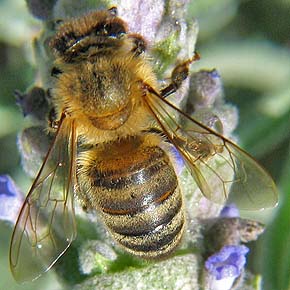 The introduced honeybee, Apis mellifera, is about 12 mm long and yellow-brown, or dark brown to black in colour.
The introduced honeybee, Apis mellifera, is about 12 mm long and yellow-brown, or dark brown to black in colour.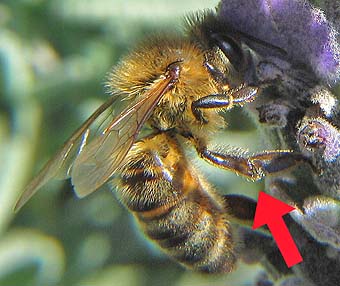
The introduced commercial honeybee has broad plates on its hind leg for carrying balls of pollen.
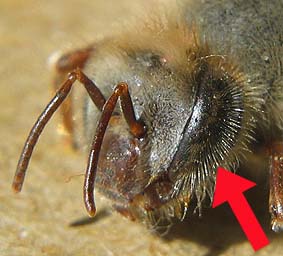
The introduced commercial honey bee also has hairy eyes but you will need a good hand lens to see this feature.
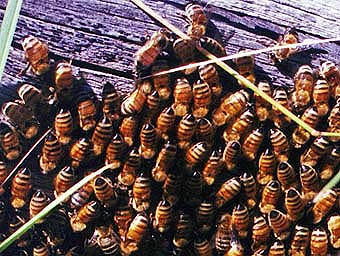
You may find a swarm of commercial honeybees clinging together in a large ball underneath a tree branch or other support.
Some swarms of commercial honey bees build nests in exposed locations such as under a branch or the eaves of a house.
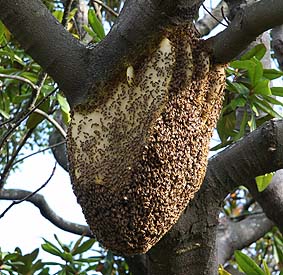 This swarm of commercial honeybees has built an exposed feral nest with large wax combs under a branch high in this tree.
This swarm of commercial honeybees has built an exposed feral nest with large wax combs under a branch high in this tree.Photograph kindly contributed by David Ritchie of Bellevue Hill.
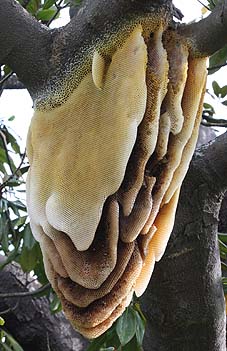
This is what this feral commercial honeybee nest looked like when the bees were removed.
Photograph kindly contributed by David Ritchie of Bellevue Hill.
Other swarms of commercial honeybees build nests in enclosed cavities, such as inside a wall, a chimney, a compost bin or a tree hollow. In this case you will see dozens of honeybees flying in and out of a single entrance hole leading to the cavity.
|
Feral honey bees compete with native bees and native birds for food and nest sites. Feral honeybees may also carry bee diseases that could threaten Australia's managed honeybee hives kept for crop pollination and honey production. We recommend that you call a pest controller to have the nest removed. Look up the Yellow Pages telephone directory under 'Bee & Wasp Removals'. Don't forget that honeybees can sting. It is best to stay away from them and seek professional assistance. |
Social Native Bees
Australia also has some native species of social bees (Tetragonula - previously calledTrigona - andAustroplebeia). However, our Australian social native bees are black and only 4 mm long.
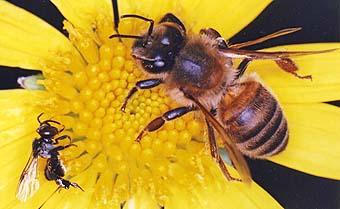
The social native bee (on the left) is much smaller than the commercial honeybee (on the right).
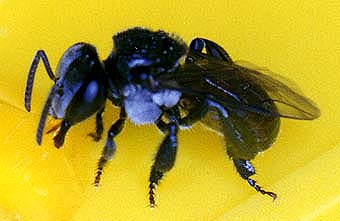
A Tetragonula carbonaria social native bee
More stingless bee photos
They are found in warm areas in Queensland, the Northern Territory, northern parts of Western Australia, and in northern and eastern parts of New South Wales.
Our social native bees sometimes build nests inside walls or in cavities under footpaths.
Our social native bees sometimes build nests inside walls or in cavities under footpaths.
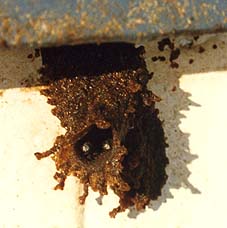
Two stingless bees peek out of their elaborate resinous entrance tunnel in North Queensland. Their nest is inside the wall cavity of the house.
|
These bees are stingless and many home owners enjoy these miniature house guests. They make a great conversation piece and a safe natural history lesson for the children.
Nests of these bees can be boxed. Our booklet,Boxing and Splitting Hives presents a complete do-it-yourself guide. The bees can sometimes also be coaxed to build a new nest in a box mounted in front of their nest entrance. Read our free Aussie Bee Online article:Natural Hive Duplication. |
Solitary Native Bees
There are hundreds of species of solitary native bees in Australia in a wide range of colours and sizes. Many nest in burrows in the ground. Others nest in pre-exisiting crevices or holes in timber.
In solitary native bee species, the adult bees generally only fly during the warm months and die before the winter. Immature bees remain sealed in their cells inside the nests during the winter. They develop into adults and emerge when the warm weather returns.
Common types of solitary native bees seen around houses include:
Blue Banded Bees
These beautiful bees have red brown fur on their thorax and a black abdomen with blue to whitish stripes. They are about 11 mm long.
Blue banded bees nest in shallow burrows in the soil underneath houses, or in mudbricks or soft mortar.
Click here for more information on blue banded bees nesting in mudbricks or mortar.
Click here for more information on blue banded bees nesting in mudbricks or mortar.
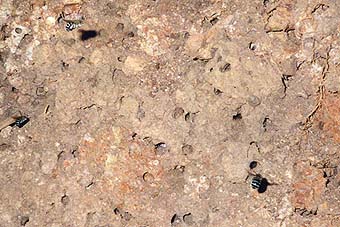
Three blue banded bees search for their nest entances in this bank of clay soil underneath a house. There are many blue banded bee nest burrows in this bank, some freshly dug but most disused.
Teddy Bear Bees
These fat bees are covered with golden brown fur except for one or two dark stripes across their abdomen. They are about 12 mm long.
These fat bees are covered with golden brown fur except for one or two dark stripes across their abdomen. They are about 12 mm long.
Teddy bear bees may nest in shallow burrows in clay soils underneath houses.
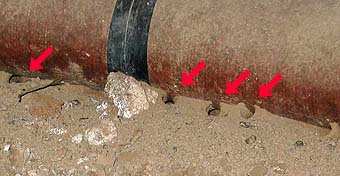
A row of teddy bear bee nest entrances in the soil, along the edge of an old roll of lino lying under a house.
Although teddy bear bees fly with a loud buzz and may fly around you in a curious manner, they are not aggressive and just want to get on with their nest building. They can sting but in our experience only do this if you grab one or step on it.
Burrowing Bees
Some other varieties of solitary native bees may build nests in deeper burrows in the ground in urban areas. Loose earth escavated from the burrow may surround the entrance hole in a small mound.
Each nest burrow may be occupied by just one bee or in other species, a number of bees may share a burrow. Sometimes quite a few nest burrows may be found close together in the one area.
Examples include: Leioproctus, Homalictus, Lasioglossum.
Some other varieties of solitary native bees may build nests in deeper burrows in the ground in urban areas. Loose earth escavated from the burrow may surround the entrance hole in a small mound.
Each nest burrow may be occupied by just one bee or in other species, a number of bees may share a burrow. Sometimes quite a few nest burrows may be found close together in the one area.
Examples include: Leioproctus, Homalictus, Lasioglossum.
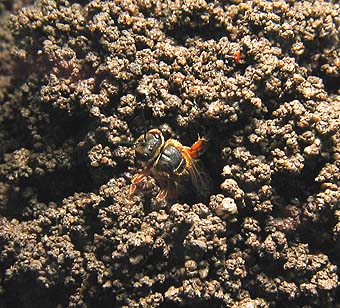
A Lasioglossum bee exits from her nest burrow.
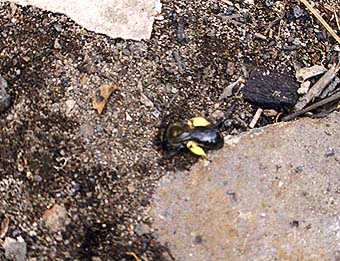
A Leioproctus bee heads down her nest burrow carrying bright yellow pollen on her hind legs
Resin Bees and LeafcuttersOther varieties of Australian native bees may build their nests inside pre-existing crevices or narrow cavities. Resin bees and leafcutters are examples of bees that may do this.
Resin bees build tiny resinous cells for their eggs inside the cavity then seal the entrance with a resin plug.
Leafcutter bees cut regular circular or oval shaped pieces of leaf and use them to build tiny cradles for their eggs inside the cavity.
Resin bees build tiny resinous cells for their eggs inside the cavity then seal the entrance with a resin plug.
Leafcutter bees cut regular circular or oval shaped pieces of leaf and use them to build tiny cradles for their eggs inside the cavity.
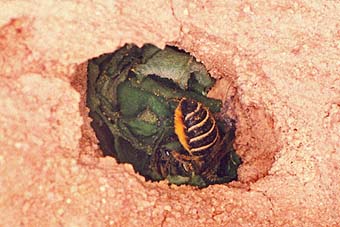
A leafcutter bee putting the final leafy layers on her nest seal in a narrow hole in a mudbrick building.
More leafcutter bee photos
|
Urban development has destroyed countless solitary native bee nests. Our Australian native bees are a precious resource for the future pollination of our bushland and crops. Adult solitary bees generally only fly for a few months in the warm weather and solitary bees can be great garden pollinators. If at all possible, please protect your solitary native bee nests. Find out what native bees live in your area. To learn more about our solitary native bees, read our native bee field guide. |
Disclaimer
The Australian Native Bee Research Centre accepts no liability for any loss or damage arising from the use of the information on this webpage. |
Author: Anne Dollin
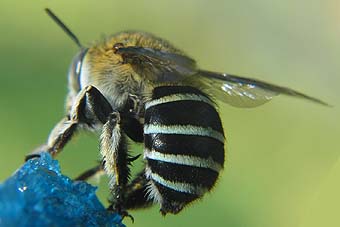
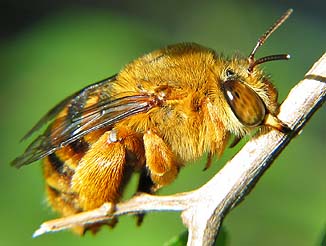
Tidak ada komentar:
Posting Komentar